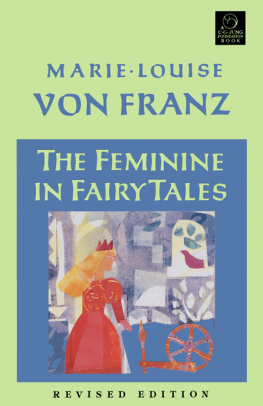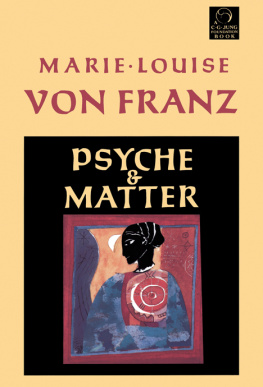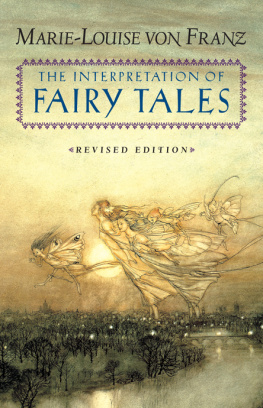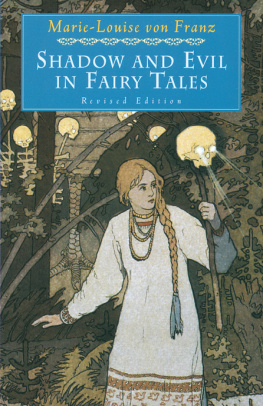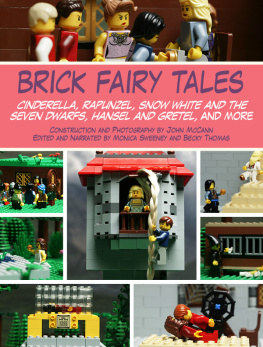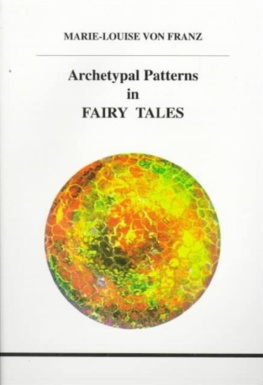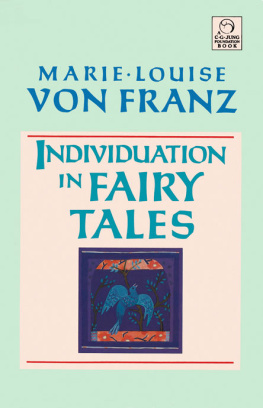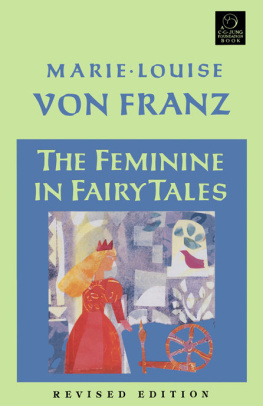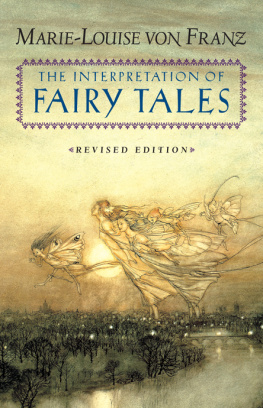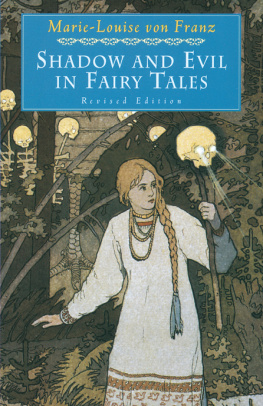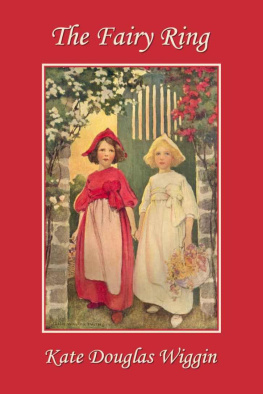Sign up to receive news and special offers from Shambhala Publications.

Or visit us online to sign up at shambhala.com/eshambhala.

C. G. JUNG FOUNDATION BOOKS
The C. G. Jung Foundation for Analytical Psychology is dedicated to helping men and women to grow in conscious awareness of the psychological realities in themselves and society, find healing and meaning in their lives and greater depth in their relationships, and to live in response to their discovered sense of purpose. It welcomes the public to attend its lectures, seminars, films, symposia, and workshops and offers a wide selection of books for sale through its bookstore. The Foundation also publishes Quadrant, a semiannual journal, and books on Analytical Psychology and related subjects. For information about Foundation programs or membership, please write to the C. G. Jung Foundation, 28 East 39th Street, New York, NY 10016.
The Feminine in Fairy Tales
Revised Edition
Marie-Louise von Franz

Shambhala
Boulder
2017
SHAMBHALA PUBLICATIONS, INC.
4720 Walnut Street
Boulder, Colorado 80301
www.shambhala.com
1972, 1993 by Marie-Louise von Franz
All rights reserved. No part of this book may be reproduced in any form or by any means, electronic or mechanical, including photocopying, recording, or by any information storage and retrieval system, without permission in writing from the publisher.
LIBRARY OF CONGRESS CATALOGING-IN-PUBLICATION DATA
Franz, Marie-Louise von, 1915
[Problems of the feminine in fairy tales]
The feminine in fairy tales / Marie-Louise von Franz.Rev. ed.
p. cm.
Originally published as: The problem of the feminine in fairy tales. Based on a series of lectures given at the C. G. Jung Institute in Zurich, 19581959.
C. G. Jung Foundation book.
Includes bibliographical references and index.
eISBN 9780834840812
ISBN 9781570626098
1. WomenFolklore. 2. Fairy talesPsychological aspects. 3. Femininity (Psychology) 4. Psychoanalysis and folklore. I. Title.
GR470.F72 1993 92-50439
398.352082dc20 CIP
BVG 01
This book is based on a series of lectures which I gave at the C. G. Jung Institute in Zurich in 19581959. I wish to express my warmest thanks to Una Thomas, who with the help of Andrea Dykes transcribed the lectures. Later, Patricia Berry shortened the text. For this edition I have revised the text, corrected mistakes, and made short additions. I want to express my greatest thanks to Dr. Vivienne MacKrell for all her help and support and also to Mrs. Alison Kappes for typing the revisions.
MARIE-LOUISE VON FRANZ
Women in the Western world nowadays seem to seek images which could define their identity. This search is motivated by a kind of disorientation and a deep uncertainty in modern women. In the West, this uncertainty is due to the fact, as Jung has pointed out, that women have no metaphysical representant in the Christian God-image. Protestantism must accept the blame of being a pure mens religion. Catholicism has at least the Virgin Mary as an archetypal representant of femininity, but this feminine archetypal image is incomplete because it encompasses only the sublime and light aspects of the divine feminine principle and therefore does not express the whole feminine principle. In studying fairy tales, I first came across feminine images which seem to me to complement this lack in the Christian religion. Fairy tales express the creative fantasies of the rural and less educated layers of the population. They have the great advantage of being naive (not literary) and of having been worked out in collective groups, with the result that they contain purely archetypal material unobscured by personal problems. Until about the seventeenth century, it was the adult population that was interested in fairy tales. Their allocation to the nursery is a late development, which probably has to do with the rejection of the irrational, and development of the rational outlook, so that they came to be regarded as nonsense and old wives tales and good enough for children. It is only today that we rediscover their immense psychological value.
If we look for feminine archetypal models of behavior, we at once stumble over the problem that the feminine figures in fairy tales might have been formed by a man, and therefore do not represent Also in various antique gnostic teachings there appears the figure of Sophia, a feminine personification of the divine wisdom, about whom the most amazing stories are told: that she was the youngest daughter of the Godhead, that she wanted to know the unknown Father, called Abyss, and by this bold wish got herself into a lot of trouble and suffering, fell into matter, and begged for redemption. This motif of the Sophia lost in matter is not only a theme in late antiquity; it appears also as the idea of the lost Shekhinah in the Jewish kabbalistic tradition. The authors of these religious writings were men. Under such circumstances, we can say that the figure of Sophia represents certain aspects of the mans anima. At other times, however, we could just as well say that the figure represents feminine psychology. The whole problem becomes in one way more, in another less, complicated if we try to concentrate on how the psychology of the feminine and the psychology of the anima are intertwined.
The real woman has an effect upon the anima and the anima upon the real woman. A woman has an educative and transforming influence on the mans eros. A man, especially if very much engaged in mental activities, tends to be a little bit coarse or undifferentiated on the eros side. He comes home tired, reads his newspaper, and then goes to bed (particularly if he is a Swiss). He does not think it necessary to demonstrate any feeling for his wife. He does not see the feminine person and her needs. Here the woman can have a transforming effect. If she can stand for her human rights without animus, and if she has a good relationship with the man she loves, she can tell him things about feminine psychology which will help him to differentiate his feelings. Since the anima of the man will have many characteristics of his mother, his first experience of woman, women in general will have a strong influence in forming and building up the mans relationship with his eros function.
On the other hand, women are influenced by the mans anima projections. For instance, they behave in a certain way and then notice that the man reacts in a bewildered or a shocked manner, because their behavior does not fit in with his anima image. Even small girls find out that if they play the part of the fathers anima, put their arms round his neck, etc., they can get a lot out of their father. Fathers daughters push aside the mother who insists on clean fingernails and going to school. They say Daddy in a charming way and he falls for the trick; thus they learn to use the mans anima by adapting to it. Women who behave in this way we call anima women. Such women simply play the role intimated to them by the man in whom they are at the moment interested. They are conscious of themselves only as mirrors of the mans reaction. Their lover will tell them they are wonderful, but if there is no man around, they feel as if they were nobody. It is only the mans reaction to them which makes them aware of their feminine personality.
Thus some women give in entirely to the anima projection. A woman I know had very small and rather weak feet, but her husband liked her to wear very high heels. She tortured herself by wearing these shoes, though doctors told her she should not. Such a woman is afraid of losing the mans affection. If he only likes her as an anima figure, she is forced to play the role of the anima. This interreaction can be positive or negative, but the woman is very much affected by the mans anima figure, which brings us to a very primitive and simple and collective level where we cannot separate the features of anima and real woman. Frequently they are mixed to some extent and react upon each other.
Next page
